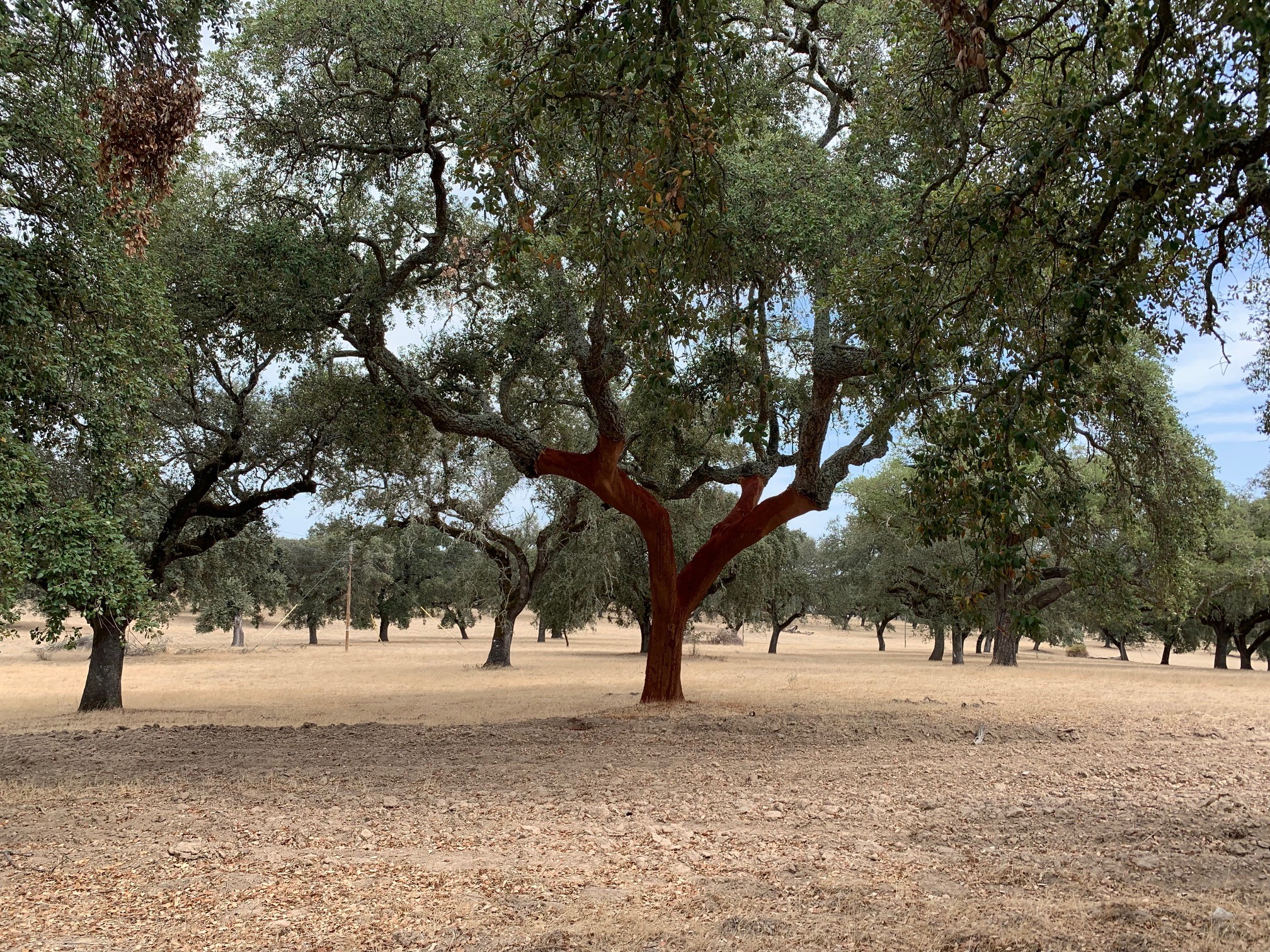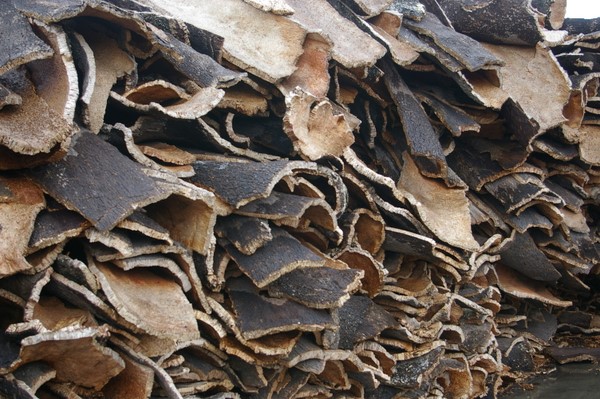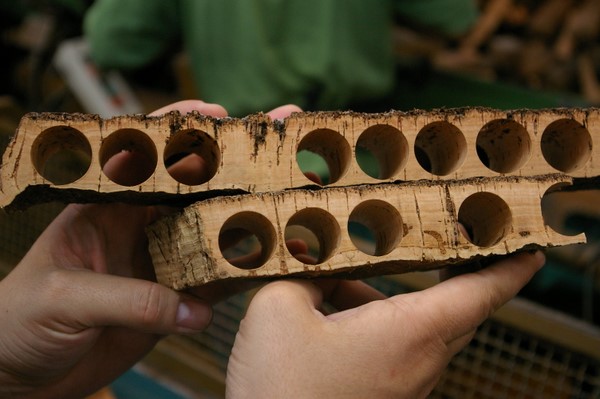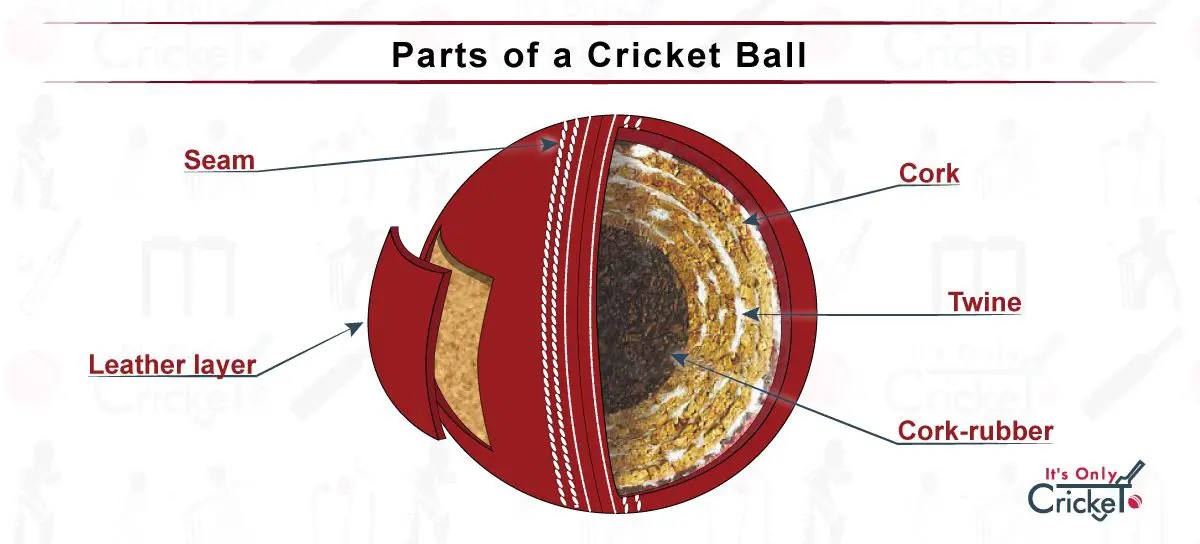By Chrissy Moore
 A few years ago, the National Herb Garden installed a display called “Beer Garden: Beer Like You’ve Never Seen It Before.” This seasonal planting highlighted many plants used in the entire beer-making industry, not just for the beer itself. One of the plants we included was Quercus suber, the cork oak. This fascinating evergreen tree, though widely used around the world, is rarely mentioned in the herb world. So, I decided it was time to pop open the story of this arboricultural workhorse.
A few years ago, the National Herb Garden installed a display called “Beer Garden: Beer Like You’ve Never Seen It Before.” This seasonal planting highlighted many plants used in the entire beer-making industry, not just for the beer itself. One of the plants we included was Quercus suber, the cork oak. This fascinating evergreen tree, though widely used around the world, is rarely mentioned in the herb world. So, I decided it was time to pop open the story of this arboricultural workhorse.
 Cork oak is a western Mediterranean staple, not just because that’s its native range, but because it has become an important agricultural crop in countries like Spain and Portugal (Schery, 1972; Uphof, 1968). While in Spain a few years ago, I was enchanted by the thousands upon thousands of trees lined up like soldiers in fields alongside the road. Clearly, this tree was a big to-do in the area. Though none of the trees I saw reached more than 15 – 20 feet under cultivation, their wild relatives can reach 30 – 50 feet and live to be more than 200 years old. Unlike the easier-to-harvest crops like corn or wheat, cork harvesting doesn’t even begin until the trees reach 15 – 25 years old! So, a Quercus suber crop is, by all accounts, a long-term investment. (With improved cultivation techniques, this time frame could be shortened significantly, though it is less common.) Fortunately for the farmers, harvests occur about 12 – 13 times throughout the tree’s lifespan, about 200 years (Cork Institute of America, N.D.).
Cork oak is a western Mediterranean staple, not just because that’s its native range, but because it has become an important agricultural crop in countries like Spain and Portugal (Schery, 1972; Uphof, 1968). While in Spain a few years ago, I was enchanted by the thousands upon thousands of trees lined up like soldiers in fields alongside the road. Clearly, this tree was a big to-do in the area. Though none of the trees I saw reached more than 15 – 20 feet under cultivation, their wild relatives can reach 30 – 50 feet and live to be more than 200 years old. Unlike the easier-to-harvest crops like corn or wheat, cork harvesting doesn’t even begin until the trees reach 15 – 25 years old! So, a Quercus suber crop is, by all accounts, a long-term investment. (With improved cultivation techniques, this time frame could be shortened significantly, though it is less common.) Fortunately for the farmers, harvests occur about 12 – 13 times throughout the tree’s lifespan, about 200 years (Cork Institute of America, N.D.).
Where does the cork actually come from? Q. suber produces a unique layer of cells that are part of the tree’s natural outer bark anatomy. Though dead, these cells are filled with air, which gives them a spongy quality—a characteristic harnessed for many products. Removing the cork layer at the appropriate time does not kill or injure the tree, but harvesting is a labor-intensive process done entirely by skilled hands.
 Once removed, the bark is brought out of the fields and left out in the open to cure for approximately six months. According to the Cork Institute of America, “The cork bark is then sorted by quality and size. The first use is for the extraction of cork stoppers to meet the demands of the world’s wine and champagne industries, which use over 13 billion cork stoppers annually” – and for good reason. Cork is impermeable to liquids and gases. Though there has been a push to use other materials for bottle stoppers, including plastic versions (Schery, 1972), cork is by far the preferred—and more sustainable—material for this purpose. Cork forests are also hotbeds of biodiversity, giving shelter to many animal and plant species. Additionally, they capture atmospheric carbon and prevent erosion in drier, windswept areas (Sousa et al., 2009).
Once removed, the bark is brought out of the fields and left out in the open to cure for approximately six months. According to the Cork Institute of America, “The cork bark is then sorted by quality and size. The first use is for the extraction of cork stoppers to meet the demands of the world’s wine and champagne industries, which use over 13 billion cork stoppers annually” – and for good reason. Cork is impermeable to liquids and gases. Though there has been a push to use other materials for bottle stoppers, including plastic versions (Schery, 1972), cork is by far the preferred—and more sustainable—material for this purpose. Cork forests are also hotbeds of biodiversity, giving shelter to many animal and plant species. Additionally, they capture atmospheric carbon and prevent erosion in drier, windswept areas (Sousa et al., 2009).
 After the stoppers have been extracted, the leftover material is processed to create many new products, some familiar, while others are less well-known. For instance, cork is very heat resistant. Therefore, “the National Aeronautics and Space Administration (NASA) uses it to insulate the engines in rockets to protect them from high temperatures” (Birkenstock USA, 2024).
After the stoppers have been extracted, the leftover material is processed to create many new products, some familiar, while others are less well-known. For instance, cork is very heat resistant. Therefore, “the National Aeronautics and Space Administration (NASA) uses it to insulate the engines in rockets to protect them from high temperatures” (Birkenstock USA, 2024).
Here are a few others:
- Soles for sandals and other footwear (e.g., Birkenstocks® and Haflinger)
- Fishing pole handles and buoys
- Cork boards and office products
- Flooring and other building materials
- Insulation panels (cork has excellent sound-dampening properties)
- Fashion accessories (e.g., purses)
- Notebook covers
- Cricket ball cores (Ahmed, 2024)
- Décor
- Dartboards
- Orchestra conductor baton handles
 Aside from the cork itself, let’s not forget that Quercus suber trees also produce acorns. These acorns are a prime feed for Iberian pigs from which jamón ibérico (Iberian ham) is derived—a quintessential menu item in Spain and Portugal. Cork oaks are a typical component of dehesas
Aside from the cork itself, let’s not forget that Quercus suber trees also produce acorns. These acorns are a prime feed for Iberian pigs from which jamón ibérico (Iberian ham) is derived—a quintessential menu item in Spain and Portugal. Cork oaks are a typical component of dehesas , “a system oriented toward simultaneous and combined land use for Iberian pig, sheep, hunting, firewood, charcoal and occasionally cork. Because of this diversity of uses, the dehesa can be regarded as a mosaic, formed of different pieces with different uses and harvests: forest, labor and pasture (Cuevas et al., 1999)” (FSC, 2014).
, “a system oriented toward simultaneous and combined land use for Iberian pig, sheep, hunting, firewood, charcoal and occasionally cork. Because of this diversity of uses, the dehesa can be regarded as a mosaic, formed of different pieces with different uses and harvests: forest, labor and pasture (Cuevas et al., 1999)” (FSC, 2014).
From corks to cricket balls, shoes to shelving paper…cork oak pops to the top of useful, herbal trees. What will they be used for next?

Photo Credits: 1) Cork oak agricultural field (Piper Zettel); 2) Cork oak with bark removed (Piper Zettel); 3) Stack of drying cork bark (wineanorak.com); 4) Bark punched through for cork making (wineanorak.com); 5) Cork-covered notebook (C. Moore) and sandal foot bed made of cork (Birkenstock USA); 6) Cricket ball diagram (itsonlycricket.com); 7) Quercus suber acorn (Giancarlo Dessì, Creative Commons); 8) Cork oak in native habitat (FSC General Assembly).
References
Ahmed, Nabil. 2023. Cricket ball construction: exploring the differences between 4-piece and 2-piece balls. https://www.cricnix.com/blog/4-piece-vs-2-piece-cricket-ball. Accessed 10 February, 2024.
Anguita, Gonzalo. 2014. The dehesas and cork production today, and its alliance with FSC. FSC General Assembly 2014. https://web.archive.org/web/20141108154927/http://ga2014.fsc.org/opinion-analysis-74.the-dehesas-and-cork-production-today-and-its-alliance-with-fsc. Accessed 22 March 2024.
Birkenstock USA. 2024. https://www.birkenstock.com/us/education/our-commitment/. Accessed 22 March 2024.
Cork Institute of America. N.D. https://corkinstitute.com/. Accessed 10 February 2024.
Schery, Robert W. 1972. Plants for man. 2nd Edition. New Jersey: Prentice-Hall, Inc.
Sousa, Vicelina B., S. Leal, T. Quilhó, and H. Pereira. 2009. Characterization of cork oak (Quercus suber) wood anatomy. IAWA Journal. Vol. 30(2), 2009:149 – 161.
Uphof, J.C. Th. 1968. Dictionary of economic plants. New York, New York: Stechert-Hafner Service Agency, Inc.
Chrissy Moore is the curator of the National Herb Garden at the U.S. National Arboretum in Washington, DC. Aside from garden maintenance in the NHG, Chrissy lectures, provides tours, and writes on various herbal topics. She serves as co-blogmaster of The Herb Society’s blog, is a member of the Potomac Unit of The Herb Society of America, and is an International Society of Arboriculture Certified Arborist. When not doing herbie things, she can be found looking after many horses.




Great article! We saw these trees in Portugal. And, of course, we bought some of the products made from the cork trees.
LikeLiked by 1 person